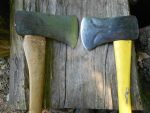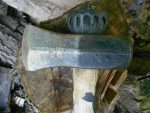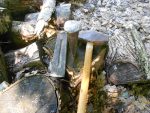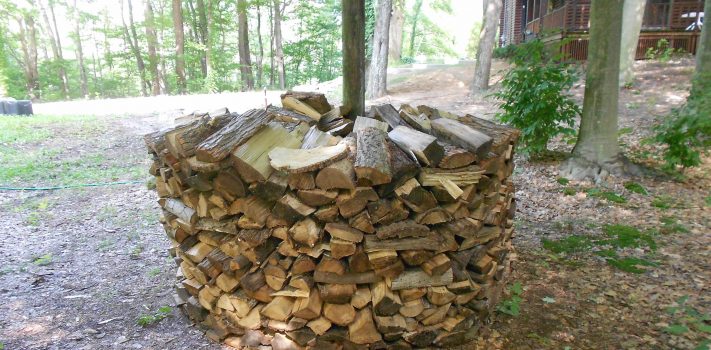Six years ago, my wife and I slipped the surly bonds of suburbia and sought refuge in less densely populated parts. We settled in a log home in the woods. The northern woods in winter are beautiful but cold. Keeping warm led to a discovery: propane is expensive. So in the interest of fiscal responsibility, we henceforth heated our home by the sweat of my brow.
The details of felling trees, limbing, bucking logs, and hauling billets belong to a tale for another day. My story today concerns splitting wood: the experiences of a smooth-handed greenhorn reducing billets of wood into pieces that will stack and dry well and then be easily handled as they are fed into a wood stove.
 I began my wood splitting journey with the heritage of my fathers: two axes, one inherited from my father, and one inherited from my father-in-law. The planes of my father’s axe are concave, tapering gently up to the eye where the head of the axe surrounds the handle. The planes of my father-in law’s axe tend toward the convex, curving more quickly outward toward its maximum width as it sweeps up toward the eye. These characteristics make my dad’s axe a felling axe, and my father-in-law’s axe a splitting axe.
I began my wood splitting journey with the heritage of my fathers: two axes, one inherited from my father, and one inherited from my father-in-law. The planes of my father’s axe are concave, tapering gently up to the eye where the head of the axe surrounds the handle. The planes of my father-in law’s axe tend toward the convex, curving more quickly outward toward its maximum width as it sweeps up toward the eye. These characteristics make my dad’s axe a felling axe, and my father-in-law’s axe a splitting axe.
The felling axe cuts deeply but spreads little. This makes it good for cutting across the grain of the wood. The splitting axe widens the cleft abruptly, before the energy of the blow can be dissipated by the friction of penetration. This makes it good for forcing the billet apart as it explosively creates a cleft parallel with the grain of the wood.
Although it is old, my father-in-law’s axe is a finely crafted and highly effective tool. I have subsequently used many different splitting tools, but I was blessed to begin my wood splitting journey with one of the best.
Many a fine splitting tool may be found at a garage sale or thrift shop, overlooked by most and sold for a fraction of the cost of a newer tool. Old tools are often among the best, products of an age when wood splitting was a matter of importance and widespread experience.
Wood and Fiberglass Handles
Like many other tasks, there are a host of wrong ways to split wood. Many of these wrong ways involve hitting the billet of wood with the handle rather than the head of the axe. As a result, inexperienced users can be very hard on axe handles. After I had broken two rather nice wooden handles in relatively rapid succession, I decided it might be worth while to give a fiberglass handle a try.
The union of my father-in-law’s axe head and a fiberglass handle is a happy one. They are still working harmoniously together many years after first being joined. I believe this is partly due to the superior strength of fiberglass as compared to wood. I also flatter myself that greater experience has made me less of a hazard to the handle than I was previously.
Based on this initial success, I subsequently united fiberglass handles with splitting maul heads. These unions were not as happy. The heavier heads placed greater stress on the epoxy that joined the heads to the handles. These stresses gradually cracked the epoxy, resulting in repeated separations and eventual divorces.
These sometimes spectacular separations emphasized another important lesson of wood splitting: be aware of what you are splitting toward. A lost axe head may split something you do not intend to split. This problem was partly responsible for the establishment of the cities of refuge in ancient Israel. As we are told in Deuteronomy 19:5, “As when a man goeth into the wood with his neighbour to hew wood, and his hand fetcheth a stroke with the axe to cut down the tree, and the head slippeth from the helve, and lighteth upon his neighbour, that he die; he shall flee unto one of those cities, and live”.
Gloves
 When a smooth-handed greenhorn splits wood, he quickly becomes interested in the question of gloves: which ones provide the best protection, are the most comfortable, wear the longest, and cost the least. Gloves are a highly personal subject matter that excites strongly held opinions. It is therefore with some trepidation that I assert that some synthetic materials hold up to the stresses of splitting better than genuine leather. I suspect that there may be some dispute on this point. I bought my current favorite gloves after they were placed on clearance at a local hardware store. I am hoping to find a suitable replacement before the entire supply that I secured through that clearance sale wears out.
When a smooth-handed greenhorn splits wood, he quickly becomes interested in the question of gloves: which ones provide the best protection, are the most comfortable, wear the longest, and cost the least. Gloves are a highly personal subject matter that excites strongly held opinions. It is therefore with some trepidation that I assert that some synthetic materials hold up to the stresses of splitting better than genuine leather. I suspect that there may be some dispute on this point. I bought my current favorite gloves after they were placed on clearance at a local hardware store. I am hoping to find a suitable replacement before the entire supply that I secured through that clearance sale wears out.
The Stump
What you have under a billet of wood while you split it is almost as important as what you are splitting it with. An extremely firm surface that will not damage the edge of the tool is vitally important.
By happy coincidence, I needed to fell a 100 foot hard maple tree right in the area where I desired to concentrate my wood splitting efforts (the tree was shading our garden). The deeply rooted stump provides a thoroughly solid base for my splitting. Since the billets I split average about 16 inches in length, I cut the stump level at about 20 inches above the ground. This places the tops of the billets at a convenient height for splitting.
The Tire
I found early on that I could expend a great deal of energy picking up split pieces of wood off the ground. Splitting inside an old tire placed on top of the stump usually keeps the split pieces within the tire. This is a more convenient location for collecting them and placing them into a wheel barrow for transport to the wood stack. The tire can also help to support billets that otherwise might be unstable and tip over.
The sidewalls are cut away from the underside of the tire to keep from collecting rain water. There are enough mosquitoes in the woods without providing them with a prime site for laying their eggs.
The Eight Pound Splitting Maul
 Although my father-in-law’s splitting axe is an excellent tool, it is not heavy enough for some of the more difficult splits. An eight pound splitting maul can apply considerably more force at the point of impact than a splitting axe. My eight pound maul initially came with a wooden handle. When I eventually broke that handle, I tried to join the head to a fiberglass handle designed for a sledge hammer. This was one of the unhappy unions mentioned above. After repeated separations, that effort was abandoned.
Although my father-in-law’s splitting axe is an excellent tool, it is not heavy enough for some of the more difficult splits. An eight pound splitting maul can apply considerably more force at the point of impact than a splitting axe. My eight pound maul initially came with a wooden handle. When I eventually broke that handle, I tried to join the head to a fiberglass handle designed for a sledge hammer. This was one of the unhappy unions mentioned above. After repeated separations, that effort was abandoned.
I finally replaced the fiberglass handle with a wooden pick handle. This has been a happy and enduring union.
The Four and a Half Pound Splitting Maul
Swinging an eight pound splitting maul can become tiring. This reality led me to purchase a four and a half pound splitting maul. It is an effective intermediate tool for splits that are too difficult for a splitting axe, but which do not require the full force of an eight pound maul. I eventually noticed a flaw in the design of the smaller maul. The stress of supporting the moderately heavy head is too great for the epoxy that joins it to the fiberglass handle. The epoxy eventually fails. After re-gluing the handle a number of times, I took advantage of the maul’s five year warranty to replace it.
Th epoxy on the replacement maul is now also showing signs of upcoming failure. When those prophecies are fulfilled, I plan to replace the current handle with a wooden pick handle.
Maintenance
 God’s word tells us in Ecclesiastes 10:10, “If the iron be blunt, and he do not whet the edge, then must he put to more strength: but wisdom is profitable to direct.” Taking good care of tools greatly increases their effectiveness. Each time I put my splitting tools away, I perform three basic maintenance tasks. First, I clean the head of the tool with a wire brush. This removes any excess dirt and vegetable matter that may retain moisture and thus encourage corrosion.
God’s word tells us in Ecclesiastes 10:10, “If the iron be blunt, and he do not whet the edge, then must he put to more strength: but wisdom is profitable to direct.” Taking good care of tools greatly increases their effectiveness. Each time I put my splitting tools away, I perform three basic maintenance tasks. First, I clean the head of the tool with a wire brush. This removes any excess dirt and vegetable matter that may retain moisture and thus encourage corrosion.
Second, I take a sharpening stone and gently hone the edge of the blade about 20 strokes on each side. This smooths away any dings or dents that may be developing on the edge.
Finally, I spread a thin layer of motor oil over the head, and polish it with a rag until it is no longer visible to the eye. This provides some corrosion resistance while the tool is in storage.
The Sledge and Wedge
 I also inherited some wedges and a sledge hammer from my father. This can be an effective set of tools for especially difficult splits, since the wedge does not need to be withdrawn from the cleft between each stroke like the head of a splitting axe or maul needs to be withdrawn. Thus no energy is wasted by removing the head or by reopening the cleft during the next stroke. The process of using the wedge and sledge, however, is noisy and tiring. I don’t generally need to wear hearing protection while splitting wood, but it may be advisable to do so when using the sledge and wedge.
I also inherited some wedges and a sledge hammer from my father. This can be an effective set of tools for especially difficult splits, since the wedge does not need to be withdrawn from the cleft between each stroke like the head of a splitting axe or maul needs to be withdrawn. Thus no energy is wasted by removing the head or by reopening the cleft during the next stroke. The process of using the wedge and sledge, however, is noisy and tiring. I don’t generally need to wear hearing protection while splitting wood, but it may be advisable to do so when using the sledge and wedge.
I have come to the point where I rarely invest effort in a billet that is so difficult as to require the use of the sledge and wedge. I have enough good billets to split without wasting my time on the most difficult ones. Instead, I usually just burn especially difficult pieces in my outside fire pit.
(To be concluded tomorrow, in Part 2.)











This is a needed description. Convex edges are also much stronger, less likely to chip, and can take abuse, whereas the cutting edge does need to be sharp as possible to cut, rather than split.
This is an unconventional way, to sharpen axes and hatchets, I discovered while milling an aluminum automotive cylinder head warped by overheated motor. I live too far from the big city, and I am too cheap to send it to a machine shop, so I do it the old fashion way, and can mill heads within less than .002″ of flat, or within factory specifications. To save money, instead of buying another stone, I use wet and dry sand paper of a course ,and very fine grit, affixed with an automotive headliner spray glue, to a flat and square pressed board, approximately 8″ x 8″. This makes for a large flat abrasive surface that can quickly shape, and then finely hone an edge on a felling ax or hatchet. Instead of a circular motion with a stone, the sand paper board can be run perpendicular to the head, or in-line along the edge, back and forth, to create a uniform, fine, and sharp edge. If the edge is damaged or mis-shaped, start with a wet and dry 180 grit to remove material and shape, and eventually hone with 400 grit. Rinse the metal dust away with water if needed. The smaller hatch head can be moved against the paper, or visa versa. A hatch edge can be as sharp as a knife, and be mirror shiny. The finer the edge, the longer it will hold a sharp and effective edge, especially good for feathering a stick in preparation for a fire, or cutting any material.
When complete, it looks like a professional job was done, even though it was a hillbilly hack job instead. This works for butcher, and other large blades too. So next time you blow a head gasket, you can also sharpen up the ax. Given recent news, sometimes it is good to have an ax to grind. If this hillbilly milling machine can flatten a cylinder head to within the same tolerances as a machine shop can, it is no joke. And it is a cheap hack!
Thank you. This should work for many other types of edges too, like knives.
My hillbilly hack is an alternative way, an innovative and effective way, but the best way is with a file and stone for axes, and for hatchets, large stones, such as a Japanese water stone from course to very fine, is the very best. Yet less expensive stones will do an adequate job most of the time. I was having fun describing an alternative, and very inexpesive way to achieve quick and simular results. When it comes to knives, diamond ‘stones’ can make a knife hair popping sharp, with less work. I would rather buy a middle of the road implement, and means to keep it sharp for my life time, rather than spend hundreds on a blade I cannot sharpen easily.
Sharpening tools, of any kind will be in short supply. If the tool is not sharp, it can be dangerous to useless. Do spend the money on quality stones and files, and learn the techniques. Yet there are alternatives should any one find themselves without…
Wow! This is an awesome article! The balance of information and humor is very effective in helping to teach. Also, the writer is not so much of an expert that he forgets his early mistakes. I especially like the “here’s why you want to do it this way “. I’m looking forward to part II.
Everyone should learn to cut and split firewood. But I offer a word of caution. As a foolish young (now old) Alaskan I split …… all by hand ….. the largest, gnarliest, nastiest spruce on my property for over forty years. I used a variety of hand tools finally settling on a Monster Maul (which I still have and look at with almost a smile).
After years of splitting a minimum of eight cord per year (one year over twelve cords) I developed a major shoulder tear which resulted in a failed surgery. And now with my other not so good shoulder I no longer dare split wood manually.
So…….. my recommendations for all the young woodsman. Learn to split firewood efficiently by hand; but buy a quality gasoline log splitter and save the wear and tear on your body for the time when power is not available.
Anyone have any recommendations for good gloves for this? I am currently trying the Mechanix with 4x material (jury is still out on these) after going through cheaper leather ones at a too quick rate.
Let me know how those Mechanix gloves work out. I need something to replace my current gloves when they wear out.
Also, does anyone know of a place that sells just right handed gloves. I wear out the right hands much faster than the left. If I had two rights for every left, it would be just about right.
I’m just the opposite. Since I handle the split wood with my left hand I always wear out the left one. We should get together.
Sounds good. Mr. Rawles, could you give Wayne my email address?
I agree 100% with advice given by Tomin Alaska. I am 60 years old, and cut and split about 15 cords a year. The only reason that I can still do this at 60 is because I do not split wood with a maul. I use a gasoline powered Ram Splitter, and my upper back, shoulders and pectorals are spared the abuse, and still work. My lower back is shot, because I still have to lift the big discs onto the machine, but my upper body muscles still work.
Hand splitting wood makes for great stories, and when I was younger, I’m sure my hand wood splitting physique got me plenty of female companionship, but the gas wood splitter is the reason I can still burn wood to heat my home at age 60.
My 34 year old son still can’t keep up with me when it comes to machine splitting wood, and he always offers to go half on buying pre-split and dried firewood. What, buy split wood? Who in the world would do such a thing? The next thing you do after buying pre-split wood is start buying pre-sliced bread. After that, I guess you might as well just give up and lay down and die.
Regarding the best gloves to use – whatever works best for you is the best. As a welder I used on a roadside in Wyoming years ago told me, as he was welding up a crack in the frame of a lowboy, in December, in the snow, with bare hands. I asked if he wanted gloves. His reply, “Nah, never use em, gloves cost money, skin grows back.”
PS: Most all gloves are made in China anymore, so you’re going to get mostly an inferior product (not always) so beware. If you can find Elk at a decent price, buy ’em, they last beyond most every other leather. Cowhide splits too easily, pig skin is iffy, goat is long lasting but to thin for most tough chores, best for light wear projects, cloth simply not wearable in the long run but cheap. Not advisable for handling cables or chokers. Rubber palmed, hot but wear long & good for wet or damp chores. See above, whatever is comfortable and best suitable for chore.
I noticed the photo of your splitting wedges and was aghast at the amount of mushrooming of the striking faces. You need to IMMEDIATELY grind away the peened-over areas. The striking force of the sledge can cause bullet sized pieces of the wedge to break off at incredible velocity – enough to cause serious and potentially lethal injury. The same should be done with other impact tools such as punches and chisels.
I had already drafted a comment on that same point, which will appear at the end of Part 2.
Thanks for the input. I will do that.
Thank you, Doc. I will do that.
I too just recently got a gas powered splitter, but for many years used a 6lb maul for all my splitting. Missouri winters aren’t THAT bad, so I never needed to split 15 cords a year, though! Don’t know really how much we used, since I tend to cut wood all through the winter, and it’s never all piled up at once. But now with the gas machine, I don’t have to split wood by the light of the porch light after work anymore!
All 115 pounds of me really sucks at splitting wood with an axe. We have an awesome electric log splitter and an awesome hydraulic one for when it is -30 and the engine freezes on the electric one.
ie: that smaller maul. I split six to eight cords a year, fir, larch, and lodgepole. I have found that giving the maul a slight twist on impact helps a lot.
You can often find just the used splitting maul heads by themselves for sale for a buck or two. I always buy them to have a spare or two. I have used them as a wedge by themselves, if needed. I primarily use wood handles, and fiberglass as a backup.
To help preserve your wood handle, get a piece of tire inner tube 3-4 inches width and wrap the handle with it just below the head, at least two layers. Then get 3-4 wraps of good duct tape around the piece of inner tube.
I had my brother weld a piece of pipe on one head and it works great as a short handled maul, as a wedge with a handle on it to be struck by another maul, or to split wood with the blade side.
I favor a wood handled maul, and there is a technique to selecting a proper hickory handle for any tools using them. Look at the butt end. It’s preferable if you see a bunch of the growth lines all tightly spaced and running on the same angle that the ax blade or maul head runs. Not running at a angle to left or right of the ax blade angle.
Also, hold the handle at the butt and extend it at arms length and look down it. It should be straight and true with no curves or bent angles.
A handle with these two features will be much more easy to use, won’t tend to so easily break, will go into the wood straighter, split wood easier, than a wood hand that twists when it goes into the wood being split because the handle grain is angled, and/or the handle is crooked.
Don’t be surprised if every handle you check at a store is poor quality, if they all came in the same batch.
Also, be wise and protect your eyes. Especially when frigid temps. I saw an amazing picture of a poor guy who had an ax head break off when splitting frozen wood, and it bounced up and split his forehead open. I’ve had pieces of wood fly up and hit me when splitting by hand.
I never wear gloves when splitting.
One last tip: always treat your wood handles with the love they deserve. Wipe them down with linseed oil often. I do all my wood handles twice a year, fall and spring. It makes them last years longer, they are much smoother to let your hands slip back and forth without blistering, don’t hurt your hands as much, and use much less energy from you.
Make sure to treat all the handle before you put on the protective wrapping I just described. That part of the handle is weakest and most abused, where treated wood stays more flexible and resists breaking.
God Bless
I primarily heat with oil, but burn wood to augment that. It’s nice to get that wood stove roaring in a blizzard and the power is out. I go through about 6-8 cord a year of red oak, sugar maple and some white birch.
I highly recommend the “Fireside Friend” from Estwing. It is essentially a heavy wedge with the handle of a hammer forged as a single piece and made in the USA. It works remarkably well as a one-handed splitting maul. I no longer worry about kindling. I take a piece of firewood off the stack and stand it on end and can split pieces 1/8″ to 1″ thick from it. I can often start the fire without even a single piece of newspaper. I have also used it as a wedge. It’s kind of nice to hold it by the handle when swinging the engineer’s hammer.
I love it and use it so much I bought a spare. You know, two is one…
I agree 100% with advice given by Tomin Alaska. I am 60 years old, and cut and split about 15 cords a year. The only reason that I can still do this at 60 is because I do not split wood with a maul. I use a gasoline powered Ram Splitter, and my upper back, shoulders and pectorals are spared the abuse, and still work. My lower back is shot, because I still have to lift the big discs onto the machine, but my upper body muscles still work.
Hand splitting wood makes for great stories, and when I was younger, I’m sure my hand wood splitting physique got me plenty of female companionship, but the gas wood splitter is the reason I can still burn wood to heat my home at age 60.
My 34 year old son still can’t keep up with me when it comes to machine splitting wood, and he always offers to go half on buying pre-split and dried firewood. What, buy split wood? Who in the world would do such a thing? The next thing you do after buying pre-split wood is start buying pre-sliced bread. After that, I guess you might as well just give up and lay down and die.
You are hilarious. Thank you for the good laugh.